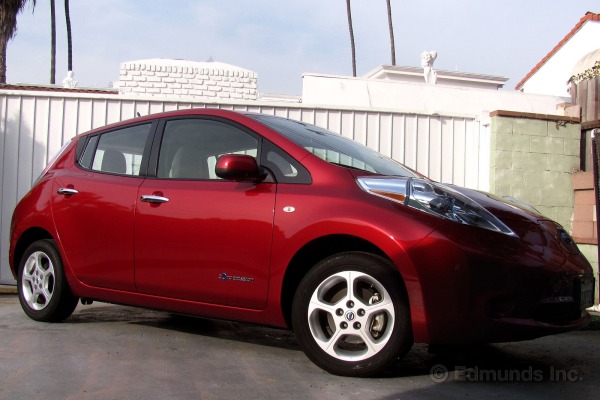
I was almost halfway through the lease on my 2011 Nissan Leaf SL when I got an intriguing offer from the dealership that sold me the car. I could turn in my current Leaf, get a brand-new 2012 Leaf and reduce my payments. Who would say no to that?
Car-industry insiders call this a "lease pull-ahead" program. Most of these offers come from the lending arms of the carmakers. In other cases, such as mine, the dealer initiates the offer either to build up used-car inventories or to sell an abundance of certain slow-selling models.
Manufacturers use these deals to "ensure that the customer 're-ups' and stays in the family," says John Sternal, spokesperson for Swapalease.com. Don't confuse such offers with early lease terminations, which are often used by people who are in dire financial straits or who are eager to get into a different car. In lease pull-ahead offers, the manufacturer entices otherwise satisfied customers by dangling the lure of a new car and applying attractive incentives to the deal.
When considering these early car lease return offers, "tread carefully and do your homework," advises Marv Eleazer, finance director at Langdale Ford in Valdosta, Georgia, and a contributor to F&I Showroom, a dealer publication. He adds that the considerations for pull-ahead offers are similar to early lease terminations, where additional fees and conditions might apply. However, he adds, there is no harm in researching the terms of the offer to find out if it might be something you want.
In my case, I initially paid $2,000 in drive-off fees and leased my Leaf at $449 a month for 36 months, with 36,000 miles included for the lease term. This was admittedly a hefty price for being an "early adopter" of an electric car. Now, a year and a half later, I was seeing lease specials for the Leaf for as little as $199 a month (plus tax). I had dreams of dropping my payments by $100 a month or more and saving thousands.
But then reality stepped in: I still owe $8,900 in payments. Why would Nissan willingly put me into a new car at a lower price? Still, I decided to look into it further.
I accessed my Leaf account online through Nissan Motor Acceptance Corporation and found that my current buyout amount is $22,364 — what Nissan would charge me if I wanted to buy the car. I compared this to the Edmunds.com True Market Value (TMV®) price of $24,143 and found that I might have about $1,779 of equity in my car.
At the dealership I sat in a salesman's office while his boss "ran the numbers" and called every few minutes with questions.
"The numbers aren't working out in your case," the salesman said after taking another phone call from the boss. "The best we can offer is to keep your payments the same and put you in a new car. Are you interested?"
I had come in with higher hopes than that. Plus, it would mean I would have to reapply for my carpool stickers. So I declined.
I continued talking with the salesman and the phone rang again. He cupped the receiver and said, "He wants to know what your bottom line is." When I hesitated, he added, "He wants to do the deal."
But I decide to stick with my old faithful Leaf. After all, as the lease progresses, the picture will improve. In fact, as I learned later from Sternal, most of these lease pull-ahead offers arise in the last year of the lease contract. Still, I liked the idea of moving into a 2012 Leaf since it has a heated steering wheel and heated seats.
Although it didn't work out for me, car lease pull-ahead deals will be attractive for some people. "Just getting a notice from a dealer saying they want their car and they are going to put you into a new car — that's often enough to motivate most people," says Sternal.
Early lease-end offers are increasing, Sternal says, which reflects the public's desire to make the leasing experience more flexible. Swapalease.com is set up to help people who want to end their leases early by finding someone to take over the balance of the payments in exchange for short-term transportation.
The Edmunds data department lists lease pull-ahead deals on the Incentives and Rebates pages under the "Other" heading. Program names vary according to manufacturer; Mercedes-Benz, for example, has the Loyalty Accelerator Program, which will make the final payments on the existing lease if you either buy or lease a new Mercedes. Lincoln offers a similar program on its MKZ, called the Early Bird Program, which pays the remaining six payments to anyone buying or leasing a Ford product.
Joe Spina, an Edmunds car lease expert, says manufacturers use these programs to spread out the return of certain car models so a large number of the same car isn't hitting auction blocks at the same time. So if your current lease is for 39 months, expect to be contacted after 36 months with an offer for an early lease return. In Spina's expert opinion, however, these deals don't hold a lot of value for consumers.
Eleazer points out that from the dealers' point of view, they are valuable: They get another good used car to put on their lots. Often, the dealer will pre-qualify you by appraising your used car on paper before they contact you. The used car manager then inspects your car more thoroughly if you decide to go to the dealership.
Here are a few tips for anyone who receives a lease pull-ahead offer:
If you've done your due diligence and the terms are agreeable, Eleazer advises that you go for it. "There's nothing wrong with moving to a newer vehicle and maybe even picking up a few choice options in the process," he says.
He's right about that — I'm still wishing I had that 2012 Nissan Leaf with its heated seats.